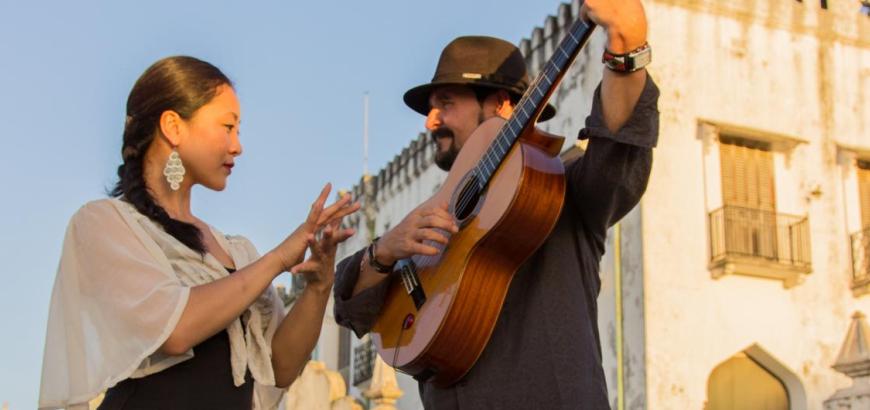Spring Quarter Ethnomusicology Visiting Artist Ricardo Garcia, a Spanish guitarist and leader of the group Flamenco Flow, performs with UW students, faculty, and special guests in this special performance of interpretations of Flamenco blended with other musical forms. With guests Amelia Moore, and José El Niño, dance and palmas; Shannon Dudley, steel pan and percussion, and Julie Gunn, voice.
Program Detail
Ethnomusicology Visiting Artist Ricardo Garcia with Guest Artists
Amelia Moore, dance & palmas
José El Niño, dance & palmas
Shannon Dudley, steel pan & percussion
Julie Gunn, voice
and UW Students
Ziyi Hu, Sahara Naini, Solmaz Shakerifard, Mike Kohfeld, Nate Lloyd, Kara Shantery, Natalie Mayhew, Graham Peterson, and Shane Shi
PROGRAM
“Viejo” c. Ricardo García (in the flamenco style of farruca)
Students of Ricardo Garcia:
Malagueña y verdiales (all)
“Romance anonimo” (all)
“Estudio No.3 Opus 60,” c. Mateo Carcassi
(with Natalie Mayhem and Ziyi Hu)
“Orfeo Negro,” c. Luis Bonfá
(with Graham Peterson)
Dance
Sevillanas
“Llanete” c. Ricardo García (in the flamenco style of bulerías)
“The Nest” c. Ricardo Garcia
(with Shannon Dudley, steel pan)
“India” c. Ricardo García
Dance
Alegrías
“Valdango” c. Ricardo García
“Rico Nico” c. Ricardo García
“Les Feuilles Mortes,”c. Joseph Kosma, lyrics Jacques Prevert
(with Julie Gunn, voice)
Rumba improvisada
(all, with percussion and dancers)
Ricardo Garcia, guitar
Born in Andalusia, Ricardo Garcia moved to France during the Franco era with his family when he was a young child. His family was musical, and he was taught to play guitar by his uncle Antonio when he was very young and learned to accompany his mother, the singer Maria del Carmen. Garcia appeared in his first concert at the age of nine, and since then has performed alone or with his aunt and uncle in all parts of France as well as internationally as a solo and ensemble artist.
Garcia's performances incorporate flamenco styles that range from free-flowing Alegrías and tangos to the emotive tientos and soleas. Arab influences as well as elements from Indian, African, South American and Caribbean music can be heard in his playing, as well as modern influences such as jazz, Latin jazz, bossa nova, and salsa, leading the Only magazine to describe his music as “a unique and devastatingly original, awe-inspiring sound.”
